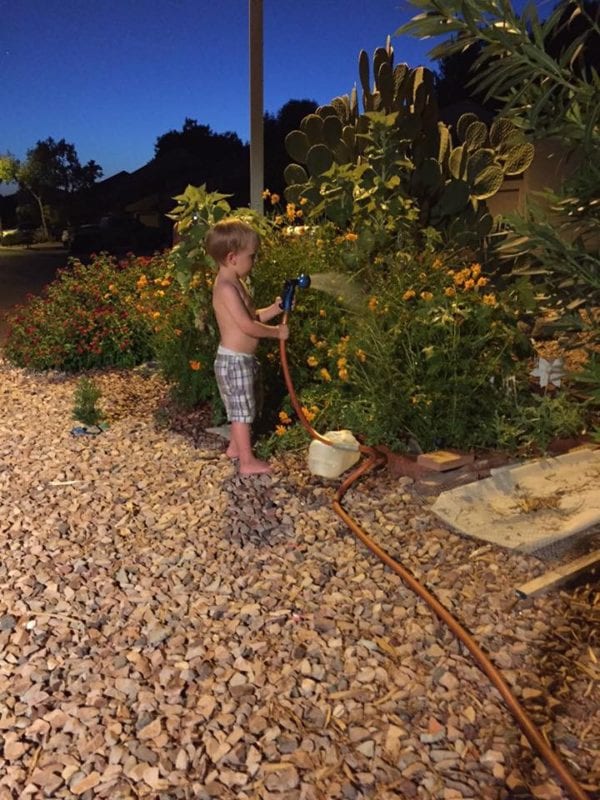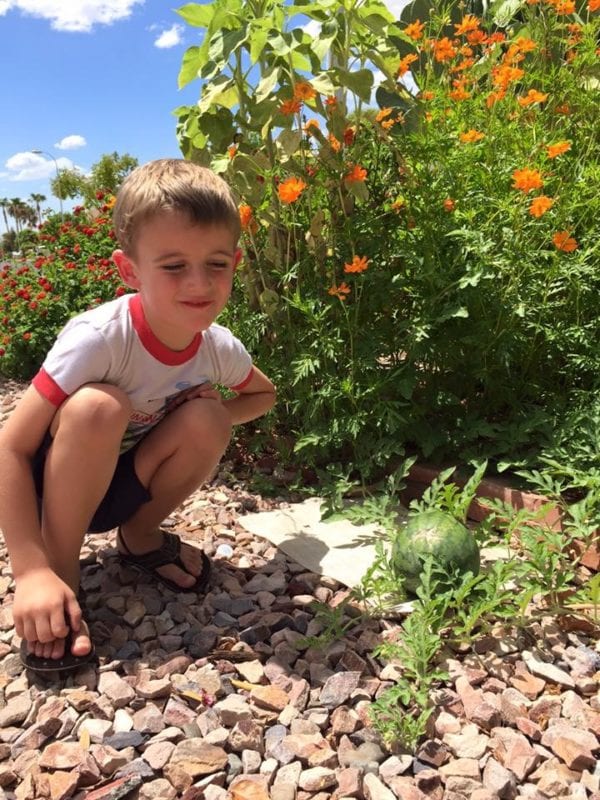Gardening is Possible Anywhere

There’s nothing like the feeling you get when you first try gardening and it works.
How we learned about urban, small space and desert gardening.
When we moved from Iowa to Arizona, I gave all of my canning jars away to friends. I certainly wouldn’t need them in the desert! When we moved into our Mesa, AZ home, it was love at first site. Finally, a yard we didn’t have to mow. The front “yard” was all rocks. The back was a patio with a small planting area of rocks. Home ownership in the desert and in an HOA was new to us. With 3 kids and one on the way, the last thing we wanted to think about was adding a lot of yard work. After a while, we were missing having a garden. It wasn’t until we were about 3 years in, that we met some urban and desert farmers that changed what we thought we knew about gardening and gave us a hunger for learning more.

Watering our garden at night in Arizona was important to help slow evaporation.
Intrigued by interesting new friends.
Chris met Urban farmers, Greg Peterson, of the Urban Farm, a college professor and Kari Spencer, a farmer who did amazing things on her 1-acre plot of land. He was really intrigued by what they had to say. They had a gardening conference in the area and invited us to come. Around this time, I was dabbling in trying to grow squash in the little rocky area behind our home and was unsuccessful. When I found out there were folks who successfully grew their family’s food in the desert, I wanted to know HOW. I attended the day long conference with a friend and came home on fire and wanting to figure out to grow green plants on our tiny rock yard. Jake Mace is also another farmer who grows 80% of his food in his backyard. I had been inspired by the best of the best.
Outsmart your HOA.
Always check with HOA rules, but for us, I took what I learned and made a “pretty vegetable garden.” I had lantana flowers bursting with summer long blooms and a patch of vibrant wildflowers and then some okra, tomatoes, watermelons and beans behind them. There were also tall sunflowers we harvested for seeds. This setup did two things. It made the garden pleasing to look at from the curb and the taller flowers worked to provide some much needed shade for plants in the hot afternoon desert sun. This was a very important tip- to have plants working together purposefully. Observing the environment is key. I found some bricks to use as edging and plotted out my little space. Soakers were arranged in the garden space so every drop of water was used and not immediately evaporated into the air at watering time in the early morning or at night. Since our ground was very rocky, I did have to dig and replace with compost and soil mix for growing vegetables. Wood chips on top provided a way to retain moisture for the plants. It’s amazing what can be learned from others.
A new perspective, vertical gardening.
Trees are another great way to have a “vertical garden.” Local folks can provide the best information as to what grows in your area. I was introduced to the moringa tree, which provides amazing health benefits. It is hardy, drought resistant, fast growing, and perfect for the rocky area behind our home. I would dry the leaves and used them in all sorts of dishes. Moringas also grow long green pods perfect for sauteing. I didn’t even have to work hard at producing this food. Who knew it could be so easy?
Talk gardening with the locals
There is an old saying, “If there’s a will, there’s a way.” Sometimes talking with the locals can give you ideas to try- or expand the menu options by trying new-to-you plants or trees that can provide you with the enjoyment and satisfaction of growing your own food.

A “pretty garden” meant making sure we had plenty of flowers to bring in pollinators and shade plants that needed partial sun.